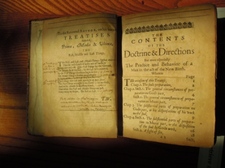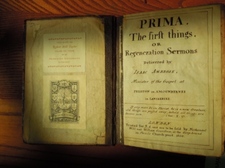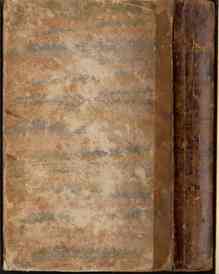In 1968, collector Robert T. Taylor presented a copy of three works by the English puritan, Issac Ambrose (1604-1664/4), all printed in London in 1650 and bound together in one calf-bound volume, repaired but retaining its early 17th century covers. It has the bookplate of Roderick Terry, clergyman and in his day, a renowned book collector of Newport, Rhode Island. When part II of Terry’s books were sold on November 7-8, 1934, this book, lot 44, sold for $55. Terry, most likely, obtained it from George T. Juckes, 35 St. Martin’s Court, London, who dubbed himself “The Bookfinder.” Juckes had the book in 1912 and detailed his speculations about it in both an article in Notes & Queries (“A Relic of John Bunyan(?)” II Series, vol 1, August 31, 1912, p. 162-163) as well as in long detailed single sheet printed description headed “A Genuine Relic of John Bunyan,” likely also dating from 1912. (Juckes priced it at £100.)
Juckes offered three arguments for tying the book to Bunyan.
1) He cited several notes either in or with the book by owners other than him saying so.
2) He noted that the subject matter of the book, indeed, a phrase repeatedly used in it — “the new birth” — conforms to language ascribed to Bunyan by his “anonymous biographer, “evidently … one who knew him well.”
3) Two authorities compared the marginal notes with two established examples of Bunyan’s handwriting and, according to Juckes, “both agree … the handwriting … is identical.”
What are we to make of these arguments?
Juckes is right when he states: “… in the year 1768 [the book] belonged to one Ludovic Auber, and has is signature in three places, also the date 1768. It afterwards passed into the hands of another owner, as the following inscription shows, “James Martin, is (sic) Book, October the 5th. 1785” Then we have another inscription in a different handwriting of about the same date, as follows, “The Notes in the magin (sic)were written by that valiant advocate for Truth, John Bunyan, while in prison.”Still later it came into the possession of Lady Gregory, wife of Dr. Olinthus Gregory, who has written the following on a sheet of old paper, “The marginal notes in this book were written by John Bunyan. I know not the evidence upon which the fact rests. but it was fully believed by my dear husband, Dr. Olinthus Gregory, A.G., Woolwich Common, June 1842.” [Juckes further adds “It then passed into the possession of Canon Acheson.”]
Moreover, the letter of the two authorities is present with the book and one authority thinks the handwriting is “very much alike.”
However, today, how much more of the literary remains of Bunyan are documented, although they are still sparse. See: * Index of English Literary Manuscripts, vol. II, 1625-1700, part 1, p —- as well as T.J.Brown “English Literary Autographs XXXIII, John Bunyan, 1628-1688” in the *Book Collector, vol 9, Spring 1960, p. 53-55.
Needless to say, the comparison of these marginal notes against a corpus larger than that known in 1912 must be done afresh. Given that this wider comparison is still undone, we must set Juckes’s contention to one side. Today, Bunyan’s authorship of the marginal notes remains an open question.
Issac Ambrose (1604-1664)
Prima, the first things; or, Regeneration sermons …[bound with] The Doctrine & Directions *[and] *Ultima.
London, Printed for J.A., and are to be sold by N. Webb and W. Grantham, 1650.
Call number (EX) 5849.122.2
Provenance:
•Ludovic Auber (1768)
•James Martin (1785)
•Olinthus Gregory = Olinthus Gilbert Gregory (29 January 1774 – 2 February 1841) mathematician
• “A.G.” = 2nd wife of Olinthus Gregory, whose identity is not known according to Oxford DNB [http://www.oxforddnb.com/index/101011469/Olinthus-Gregory].
•Canon Acheson = the Rev. Johnston Hamilton Acheson, Kirby-Cane Rectory, Bungay, Norfolk (19th cent.)
•George T. Juckes, bookseller, London
•Roderick Terry (1849-1933) (bookplate)
•Gift of Robert H. Taylor in 1968






















